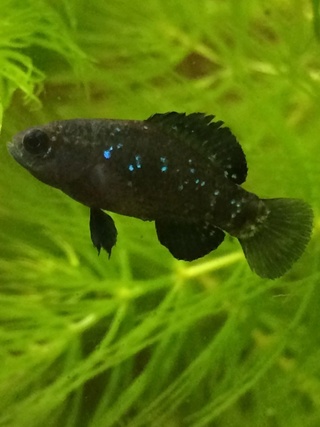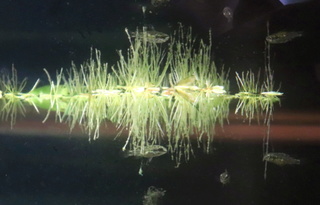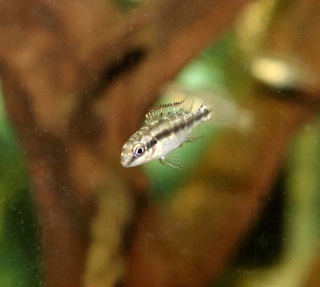What the...is that a leak? NOOOOOOOOOOO!!!!! (a comedy of horrors...)
3 posters
:: Freshwater :: Freshwater General
Page 1 of 1
 What the...is that a leak? NOOOOOOOOOOO!!!!! (a comedy of horrors...)
What the...is that a leak? NOOOOOOOOOOO!!!!! (a comedy of horrors...)
That horrid four-letter word. It chills the blood, freezes the heart and numbs the mind with fear. L-E-A-K. The bane of aquarists everywhere, scourge of contentment, destroyer of peace of mind...
I've had my latest DIY build running for a number of weeks now, problem-free. It's a 360-gallon plywood tank, glass front, sealed with epoxy. The filtration consists of an easily-cleaned foam prefilter into which water overflows from the tank. It then percolates down through a bed of wet-dry DIY media contained inside a Rubbermaid garbage can standing beside the tank, then into a below-tank DIY sump consisting of a pair of roughly 50-gallon plastic bins before being pumped back into the tank. There's nothing new or experimental about this design; I've done it many times in the past and have pretty much all the bugs worked out of it. It's easy to clean, cheap, ugly, cheap, bulky, cheap, effective, and cheap...much like myself in many ways.
Oh, forgot to mention: it's cheap.
So it's been percolating merrily away for a few weeks, after I got it all balanced and running smoothly. When first put into operation, there is some trial-and-error adjusting to be done to get it perfect. The actual water level in the tank is slightly adjustable by means of a pair of elbows mounted on the outside of the overflow, where it dumps into the garbage can...er, I mean, "wet-dry trickle filtration tower". This water level will change slightly if the flow rate of the pump is altered; more flow equals a slightly higher water level unless the elbow is rotated slightly lower to effectively lower the top of the overflow.
A few days ago I was tending to the tank when I noticed that the valve controlling flow rate was not quite open all the way. Horrors! Decreased flow rate? Unacceptable! So naturally, I opened the valve up all the way, and then did a pre-emptive tweak on the overflow elbow in an effort to maintain the water level. Got lucky, that first tweak set the level just a tiny bit lower than it had been before the change; maybe a quarter inch lower. Still perfectly fine, so I went about my business, smugly congratulating myself on my efficiency.
A few hours later I went into the basement and, of course, glanced at the tank. AAAAGGHHHH!!!! A string of water snaked from under the stand across the basement floor to the drain. What had happened? I ran my fingers questioningly over, around and beneath every joint, every bulkhead, every hose clamp...and quickly found the culprit. The exterior of the sump under the bulkhead where the water first entered was wet. Sigh. I had a leak.
How could this be? Everything had been leak tested for a week before putting it into operation. Additional weeks of function had proven smooth and flawless. And yet now...disaster.
The sump is tall; the under-tank space is cramped; the floor is always cold, and now wet to boot. I shut down the pump, crawled in and began my task. Amid the blue air that soon filled the basement, I found that the bulkhead was completely tight, the threaded adapter likewise, and the hose tightly clamped. Where and why did the leak develop? Re-doing all these joints seemed pointless when they seemed perfect, but what else was there to do? I double-triple-checked everything, added top-up water to the sump up to the appropriate mark, and re-started the pump. Opened up the bar fridge next to the tank...every fish room needs one...and cracked a cold one, then settled into my ratty old recliner to sip, read and watch my fish.
Except...what's this? There is still a thread of water beginning to wend its way out from the stand and across the floor! What is happening here??? Were there two leaks and I only found and fixed one? Nope; everything else is dry...but that same bulkhead is leaking again!
A repetition of the previous dog-and-pony show performance ensued, except this time the air was bluer, my patience was thinner, the floor was colder...and I managed to skin my knuckles with a pipe wrench. I finished and then, still laying on the floor, waited about 10 minutes and checked the side of the sump beneath the offending bulkhead. Dry as a bone.
Turned on the pump...and here comes the leak again.
Okay, it's too late to make a long story short, but...as I lay on my back on a damp, cold concrete floor, I rested my head on the clammy surface and contemplated...not for the first time...draining the dang tank and just using it to house a snake or some tortoises. With my head at that angle, my eyes rested on the top lip of the sump...right above the hateful, leaky bulkhead...in fact, I found myself looking at...a quarter inch hole in the plastic bin that was my sump, a couple inches down from the top. Perfectly centered where the handle once was, nothing I had ever drilled...a perfect factory-produced hole a tiny fraction of an inch above the water level in the sump when the pump was operating.
Except now, the water level in the tank had been dropped a fraction by the recent flow rate adjustment...which raised the water level in this section of the sump by almost an inch...which led to water pouring out of the hole every time the pump was turned on. This water trickled straight down the side, around the bulkhead, and onto the floor. The bulkhead itself was fine.
I have 6 of these plastic bins, all in use as filters or water storage vats or temporary aquariums. A quick check revealed that none of the others had this superfluous hole. But this one bin...the only one where such a hole would create chaos...ahhh, crap...
It took about 60 seconds, a single 1/4x20 bolt/nut, a pair of washers and a dab of silicone, and my leak was fixed.
The moral of the story? Who knows???
I've had my latest DIY build running for a number of weeks now, problem-free. It's a 360-gallon plywood tank, glass front, sealed with epoxy. The filtration consists of an easily-cleaned foam prefilter into which water overflows from the tank. It then percolates down through a bed of wet-dry DIY media contained inside a Rubbermaid garbage can standing beside the tank, then into a below-tank DIY sump consisting of a pair of roughly 50-gallon plastic bins before being pumped back into the tank. There's nothing new or experimental about this design; I've done it many times in the past and have pretty much all the bugs worked out of it. It's easy to clean, cheap, ugly, cheap, bulky, cheap, effective, and cheap...much like myself in many ways.
Oh, forgot to mention: it's cheap.
So it's been percolating merrily away for a few weeks, after I got it all balanced and running smoothly. When first put into operation, there is some trial-and-error adjusting to be done to get it perfect. The actual water level in the tank is slightly adjustable by means of a pair of elbows mounted on the outside of the overflow, where it dumps into the garbage can...er, I mean, "wet-dry trickle filtration tower". This water level will change slightly if the flow rate of the pump is altered; more flow equals a slightly higher water level unless the elbow is rotated slightly lower to effectively lower the top of the overflow.
A few days ago I was tending to the tank when I noticed that the valve controlling flow rate was not quite open all the way. Horrors! Decreased flow rate? Unacceptable! So naturally, I opened the valve up all the way, and then did a pre-emptive tweak on the overflow elbow in an effort to maintain the water level. Got lucky, that first tweak set the level just a tiny bit lower than it had been before the change; maybe a quarter inch lower. Still perfectly fine, so I went about my business, smugly congratulating myself on my efficiency.
A few hours later I went into the basement and, of course, glanced at the tank. AAAAGGHHHH!!!! A string of water snaked from under the stand across the basement floor to the drain. What had happened? I ran my fingers questioningly over, around and beneath every joint, every bulkhead, every hose clamp...and quickly found the culprit. The exterior of the sump under the bulkhead where the water first entered was wet. Sigh. I had a leak.
How could this be? Everything had been leak tested for a week before putting it into operation. Additional weeks of function had proven smooth and flawless. And yet now...disaster.
The sump is tall; the under-tank space is cramped; the floor is always cold, and now wet to boot. I shut down the pump, crawled in and began my task. Amid the blue air that soon filled the basement, I found that the bulkhead was completely tight, the threaded adapter likewise, and the hose tightly clamped. Where and why did the leak develop? Re-doing all these joints seemed pointless when they seemed perfect, but what else was there to do? I double-triple-checked everything, added top-up water to the sump up to the appropriate mark, and re-started the pump. Opened up the bar fridge next to the tank...every fish room needs one...and cracked a cold one, then settled into my ratty old recliner to sip, read and watch my fish.
Except...what's this? There is still a thread of water beginning to wend its way out from the stand and across the floor! What is happening here??? Were there two leaks and I only found and fixed one? Nope; everything else is dry...but that same bulkhead is leaking again!
A repetition of the previous dog-and-pony show performance ensued, except this time the air was bluer, my patience was thinner, the floor was colder...and I managed to skin my knuckles with a pipe wrench. I finished and then, still laying on the floor, waited about 10 minutes and checked the side of the sump beneath the offending bulkhead. Dry as a bone.
Turned on the pump...and here comes the leak again.
Okay, it's too late to make a long story short, but...as I lay on my back on a damp, cold concrete floor, I rested my head on the clammy surface and contemplated...not for the first time...draining the dang tank and just using it to house a snake or some tortoises. With my head at that angle, my eyes rested on the top lip of the sump...right above the hateful, leaky bulkhead...in fact, I found myself looking at...a quarter inch hole in the plastic bin that was my sump, a couple inches down from the top. Perfectly centered where the handle once was, nothing I had ever drilled...a perfect factory-produced hole a tiny fraction of an inch above the water level in the sump when the pump was operating.
Except now, the water level in the tank had been dropped a fraction by the recent flow rate adjustment...which raised the water level in this section of the sump by almost an inch...which led to water pouring out of the hole every time the pump was turned on. This water trickled straight down the side, around the bulkhead, and onto the floor. The bulkhead itself was fine.
I have 6 of these plastic bins, all in use as filters or water storage vats or temporary aquariums. A quick check revealed that none of the others had this superfluous hole. But this one bin...the only one where such a hole would create chaos...ahhh, crap...
It took about 60 seconds, a single 1/4x20 bolt/nut, a pair of washers and a dab of silicone, and my leak was fixed.
The moral of the story? Who knows???


jjohnwm- Angel Fish

- Posts : 158
Join date : 2015-09-08
Location : Interlake region of Manitoba
 Re: What the...is that a leak? NOOOOOOOOOOO!!!!! (a comedy of horrors...)
Re: What the...is that a leak? NOOOOOOOOOOO!!!!! (a comedy of horrors...)
jjohnwm wrote:That horrid four-letter word. It chills the blood, freezes the heart and numbs the mind with fear. L-E-A-K. The bane of aquarists everywhere, scourge of contentment, destroyer of peace of mind...
So funny @jjohnwm
I enjoyed the read, and couldn't help myself thinking about Das Boot or U-571...
Thanks for the story...

alexmtl- Veteran Member

- Posts : 3274
Join date : 2013-09-07
Location : Montreal Quebec
 Re: What the...is that a leak? NOOOOOOOOOOO!!!!! (a comedy of horrors...)
Re: What the...is that a leak? NOOOOOOOOOOO!!!!! (a comedy of horrors...)
Glad to see your still at it John. Still did not get the pond built what between C19 and procrastination. Thanks for sharing your story.

Fores41- Pleco Poster

- Posts : 829
Join date : 2013-09-17
Location : Williams Lake,BC
:: Freshwater :: Freshwater General
Page 1 of 1
Permissions in this forum:
You cannot reply to topics in this forum
 Alexmtl
Alexmtl


» Anyone still around? Need help transporting fish
» Stocking suggestions
» New Tank Purchase
» 3 Gallon Tetra half moon tank
» White floaty stuff in gold fish tank
» Ammonia in tap water
» Need advice for beginner with fresh water tank
» Fluval FX5 hose size?
» smart fish, dumb fish, pink fish...um, what rhymes with dumb?
» Is K&E sandblasting sand same as Black diamond?
» What the...is that a leak? NOOOOOOOOOOO!!!!! (a comedy of horrors...)
» Air stones and the noise they make
» aquatic medications
» film like stuff on the water surface of shark tank
» Articles on swordtail behaviour and fathead minnows
» Lets see your predators!
» Humane way to PTS a shark
» My tanks (Introducing myself)
» Build your own aquarium